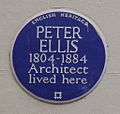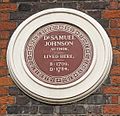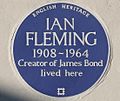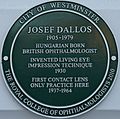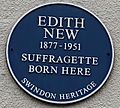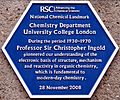Blue plaque facts for kids
The Blue Plaque is a special way to remember famous people and the places they lived or worked. These are round, blue signs placed on buildings. They help us learn about history and the important people who shaped it.

The idea started in London with the Royal Society of Arts in 1866. The very first plaques were actually red and made of terracotta. One of the first was for the poet Lord Byron.
The Society put up 36 plaques between 1866 and 1901. Then, the London County Council took over from 1901 to 1965. They were the ones who changed the plaques to the blue color we see today. Later, the Greater London Council (1965-1986) and now English Heritage have looked after the scheme. Similar programs are now used across the whole United Kingdom.
Blue Plaques Outside London
English Heritage manages the Blue Plaque scheme in London. But don't worry, you can find similar plaques outside London too! Local councils and groups run these schemes in different towns and cities.
The idea has even spread beyond the United Kingdom. For example, in June 2010, a Blue Plaque was placed on the home of Guernsey artist Peter Le Lievre. This shows how popular the idea is for celebrating important people everywhere.
Images for kids
-
English Heritage blue plaque at 22 Gladstone Avenue, Feltham, London, commemorating Freddie Mercury (erected 2016)
-
English Heritage plaque at 40 Falkner Square, Liverpool, commemorating Peter Ellis, architect (erected 2001)
-
Society of Arts plaque on Samuel Johnson's house in Gough Square, London (erected 1876). Many of the early Society of Arts and LCC plaques were brown in colour.
-
London County Council plaque at 48 Doughty Street, Holborn, commemorating Charles Dickens (erected 1903)
-
London County Council plaque at 100 Lambeth Road, Lambeth, commemorating William Bligh (erected 1952)
-
Greater London Council plaque at 29 Fitzroy Square, Fitzrovia, commemorating Virginia Woolf (erected 1974)
-
English Heritage plaque, at 22b Ebury Street, Belgravia, London, commemorating Ian Fleming (erected 1996)
-
Corporation of London plaque on the site of Lloyd's Coffee House in Lombard Street
-
City of Westminster green plaque at 18 Cavendish Square, Marylebone, commemorating Josef Dallos, contact lens pioneer (erected 2010)
-
Plaque in Oldham marking the origin of the fish and chip shop and the fast food industry.
-
The first Swindon Heritage blue plaque, commemorating suffragette Edith New, who was one of the first two suffragettes to use vandalism as a tactic.
-
Oxfordshire blue plaque commemorating the first sub-4-minute mile run by Roger Bannister on 6 May 1954 at the University of Oxford's Iffley Road track.
-
Transport Trust plaque at Hythe Pier and Railway, Hythe, Hampshire, the oldest working pier railway in the world
-
Royal Society of Chemistry plaque on the Chemistry Department of University College London, recording the work carried out there by Sir Christopher Ingold (erected 2008)
-
Institute of Physics plaque on the Parkinson Building, University of Leeds, recording the work carried out there by Sir William Henry Bragg
See also
 In Spanish: Placa azul para niños
In Spanish: Placa azul para niños



